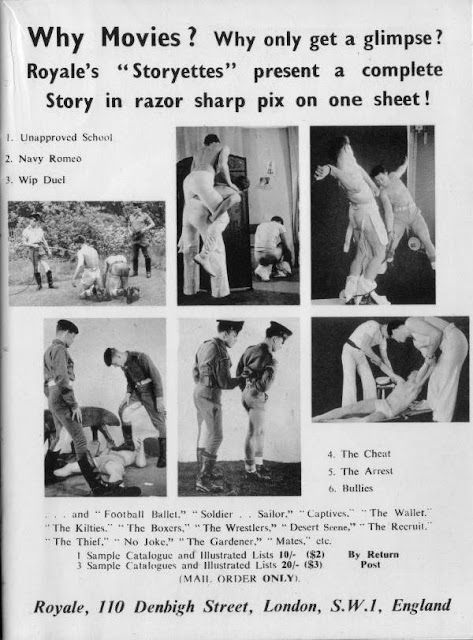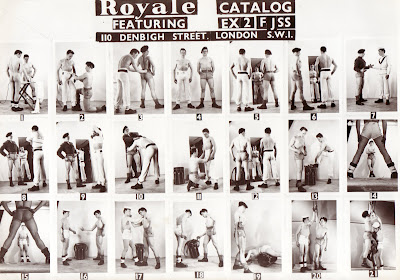The Royale Catalogue images included in the British Photographer's collection are a valuable source of information about the early years of Royale, what they did and how they traded.
Royale solicited enquiries by placing ads in beefcake magazines of the era
 |
| Royale Studio - Advertisement in a Magazine |
This one for storyettes appeared in 'Man Alive' No 7 in October 1959. It depicts a surprising selection of tantalising, homoerotic ingredients - domination, humiliation, whipping, arrests, stripping and whipping, all involving men in tight fitting and scanty clothes. Later advertisements became more discreet.
Usually there would be other Royale pictures in the body of the magazine, but in general they were conventional beefcake shots, not taken from the storyettes.
You could write to Royale requesting the latest listings of photograph sets and a sample catalogue sheet of one of the sets for the sum of 10/- (Ten shillings or £0.50 in modern money)
Back then in 1959 the average weekly wage in Britain was £9,
The price of a copy of Man Alive 7 was 3/6p or about £0.18
For US readers a dollar then was about £0.36
.jpg) |
| Royale Catalogue - List 'A' (click to enlarge) |
What you got in return was 'Lists' of photo sets like the one above.
Each List contained descriptions of the sets and pricing information.
(see Royale's 1960 Catalogue in full)
 |
| Royale Catalogue - Key List 'A' (click to enlarge) |
Each 'List' of photo sets was accompanied by a 'Key List' which was a sheet of thumbnails with one sample picture (usually) from each set in the descriptions list. These sample pictures gave customers a better idea of the contents of each set. They could then order a detailed catalogue sheet for a specific set which interested them.
Suppose you were interested in 'FJSS' ( which I've highlighted in the images above).
The description is tantalising, it reads:
CAT. FJSS "SOLDIER...SAILOR". FRED COLLINS & JOHN SKILLING CHANGE
(21 pix) 10/- INTO WHITE NAVY PANTS & SHORTS, KHAKI SHORTS. THEY QUARREL
SET 7x5 50/- & ARE TIED UP TO COOL DOWN.
The first price shown on the left is the cost of the catalogue for the set, which would have been a sheet of what we would call thumbnails today showing all the 21 pictures in the set (see below).
Typically a 12 pix catalogue sheet cost 5/- (£0.25 in modern money)
bigger sets of 24 (say) were twice the cost 10/- (0.50p).
At this point you would have spent £1 of your £9 wage.
More about pre-decimal coinage.
 |
Royale Studio Catalogue Sheet for FJSS, 'Soldier Sailor'
click to enlarge |
This is the catalogue sheet for FJSS, it would have arrived printed on foolscap paper (13" x 8") which is a shade bigger than modern A4.
This catalogue image would have been created originally by arranging separate physical photos on a back sheet and photographing the result. It was then possible to make multiple copies of the composite image from the negative.
The image quality was good so this sheet of small pictures may have sufficed for some customers and there are examples of pictures in circulation which have obviously been snipped from sheets like this.
 |
| Royale Studio Order Form |
There was a further option of ordering individual prints (7"x5" or 10"x8") of the pictures the customer particularly liked, using the form above. List 'A' above doesn't quote the price of enlargements but in a list from a year or so later (List IX) it's given as 3/6d (roughly £0.18) for a 7"x5" with a dozen for £1.50.
For the 'FJSS' set the List 'A' description (above) specifies the option of ordering the full size set of 21 pictures directly, without buying the more detailed Catalogue Sheet first.
The cost was 50/- (fifty shillings) equivalent to 2/6 per picture
which is £2.50 in modern money, roughly £0.12 per picture.
Back then your half a crown (2/6 per picture) would have bought a loaf of bread ( a proper one, unwrapped and not sliced) or half a pound of butter.
On an average wage of £9 per week, fifty shillings (£2.50) plus £1 for the catalogues was quite a significant outlay.
%20p154-2.jpg) |
| Dolphin Studio - Order Acknowledgment |
This copy of a covering letter sent with a delivered order shows that the Studio's approach was perfectly business-like. This letter was sent by Dolphin Studio which was a later off-shoot of Royale
It's signed by Clavering's business partner John Parkhurst.
The ordered photographs were sent to customers through the regular post which was completely illegal as they were deemed to be indecent. They used plain envelopes to minimise the risk of interception by postal employees. Of course, there were plenty of legitimate photos also being sent through the post. Probably the greatest risk in the days of paper envelopes was of them splitting open while the Post Office had them.
In the letter above there's a reference to 'Poste Restante', which was used to circumvent another delivery risk. It's a system whereby the Mail Service does not deliver the package to the recipient's address but holds it at a local office for the customer to collect. It's a simple way to prevent wives or other members of the household opening the unexpected package or asking about the contents. Back then it was invaluable to closeted gay men.
For more background articles click on the 'About Royale' label just below.






.jpg)




.jpg)



%20p154-2.jpg)












.jpg)

%20Manorama_10_Mar63_z0573012_ray_huggins__hussar_.jpg)

